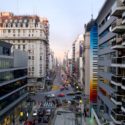 The mural is part of the artist’s “Buenos Aires heritage” series and the product of the artists curiosity. During three months he spoke to people and asked them the one question that obsessed him, namely what was the song that that best represents Buenos Aires? Little by little, he listened and grouped the answers in a YouTube list available here.
The mural is part of the artist’s “Buenos Aires heritage” series and the product of the artists curiosity. During three months he spoke to people and asked them the one question that obsessed him, namely what was the song that that best represents Buenos Aires? Little by little, he listened and grouped the answers in a YouTube list available here.
According to the artist, it was after this research that one day, walking through downtown Buenos Aires that he became aware that e was not finding what he was looking for. Coming to no conclusions, a friend advised him to look beyond music and instead pay attention to the sound of the city. This is when “64 tones of Buenos Aires” came to life.
The mural depicts a 31 m vertical piano at the intersection of Corrientes and Callao, to main avenues in downtown Buenos Aires. As explained by Pomar, the work offers a spectrum of 64 tones where each of them represents a specific characteristic of the city; blue sky, the red of the subway B line, the yellow of a taxi, the green of a handkerchief, the white of the obelisk, the grey of the asphalt and the city’s architecture, the orange of a school transport, the embroidery of a brick, the black of a tile, the green of a newspaper stand, the colours of a bus, the flags of a demonstration and on the piece, the reflections of the sun.
“The tones and many more are present in the context of this corner. Also, I think they can be heard. I did not find the Buenos Aires song. However, I found a city conducting an orchestra.” – Jorge Pomar
More about Jorge Pomar Facebook | Instagram |
Author: Fran
Founder and editor of Urbanite. Street Art lover who after the finishing her MA thesis on the Mexican and Norwegian muralist movement in the 1920-50s, developed a fascination for street art and graffiti that eventually led to collaborations with different art blogs, including the creation of this one.





You must be logged in to post a comment.